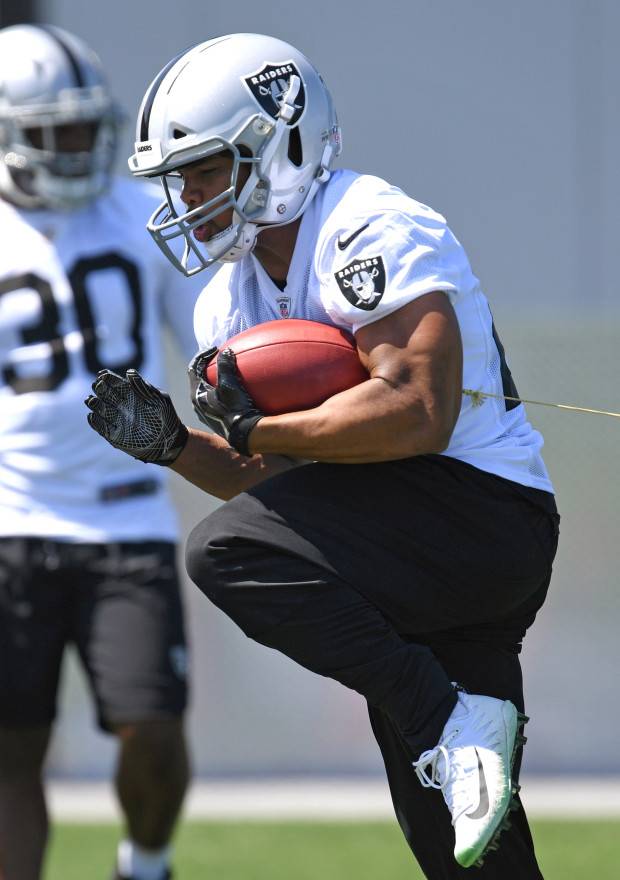
New Oakland Raiders head coach Jon Gruden has built a culture of competition heading into the 2018 season. A position that exemplifies that is running back. The Raiders didn’t address it in the draft, opting for a different approach.
Marshawn Lynch was supposed to be the finisher to Oakland’s running game. As it turned out, Lynch was pretty much the only personnel piece that gave the rushing attack any semblance of function throughout 2017. Many experts expected coach Jon Gruden to go hard in addressing the running back position this offseason, though he has largely stood back and created a true training camp battle between three players for two roster spots.
So, what has Gruden done to help the rushing attack?
Instead of a major overhaul at the position (as many predicted), Gruden has astutely addressed the other components of the running game. The decision to keep Lynch as the featured back was made early in the offseason, and Gruden went about tailoring the run game to his strengths. Gruden hired Tom Cable as offensive line coach, with the intent of implementing many of the run concepts Cable installed in Seattle with much success for Lynch. Gruden then acquired a bunch of players who are schematic fits within the attack. This includes signing lead-blocking fullback Keith Smith, blocking tight end Derek Carrier and re-signing Lee Smith. The Raiders then went about addressing their offensive line, signing Breno Giacomini in free agency, and using early draft picks on Kolton Miller and Brandon Parker. None of these signings are going to make headlines, but they are all going to play their various key roles in the rushing attack.

Oakland Raiders running back Doug Martin takes part in a mini-camp at the Raiders’ facility in Alameda, Calif., on Tuesday, April 24, 2018. (Doug Duran/Bay Area News Group)
Early in the 2017 season, the Raiders completely misused and wasted Lynch’s talent. At times, the Raiders would keep Lynch on the sidelines for entire drives at a time, instead choosing to rely on backups DeAndre Washington and Jalen Richard. The theory was somewhat sound in that they were trying to keep Lynch fresh for the fourth quarter, but it meant that he couldn’t get into a rhythm and wear down the defense early and the backups were unable to carry the load, leading to stagnation. Hence, Gruden identified that the backup running back position was an area where the Raiders needed to create competition. Hence, the Raiders were quick in free agency to sign former Tampa Bay Buccaneer Doug Martin.
Martin was a low-risk signing who the Raiders anticipate being the primary backup to Lynch. As Gruden has said on multiple occasions, Martin signed for very little money ($1.475 million per Over The Cap), and if he doesn’t work out, they can cut him without accruing any dead money on the salary cap. Martin is not as tough a runner as Lynch (very few are), though he is adept at hitting the hole with ferocity and moving the pile with his low center of gravity. It is very possible that the Raiders put Lynch and Martin on the field at the same time this season in split-back formations. Despite being a low financial risk, if Martin doesn’t pan out, the Raiders are going to be in trouble behind Lynch, because they do not trust their other backups to carry the load. At least some in the media, including our own Scott Gulbransen, believe Martin could be positioned to have a big turnaround year.
Assuming that Martin makes the roster, the Raiders will have an interesting battle for the final running back spot between Richard and Washington. Both are hard runners, though Washington is slightly the more bulky of the two. Washington is more comfortable on angle blocking concepts, while Richard is better at zone blocking principles. This may give Richard the edge, given that the Raiders are going to be using a lot of inside and outside zone under Cable this season.

Richard may have an edge over Washington due to system fit under Jon Gruden.
What is likely to determine the winner of this roster position battle is their ability as receivers out of the backfield. Washington was used extensively as a check-down leak-out option in 2017, although he had three drops compared to Richard’s one. Additionally, Richard’s average yards per catch was more than nine, compared to Washington’s 5.6. When also comparing their yards after the catch, it’s clear that Richard had more receiving yardage than Washington, not because he was catching the ball further down the field, but because he was able to get more yardage after the catch. Gruden has a history of using his running backs extensively in the passing game, so it’s not unfathomable to think that Richard could end up with 500 yards receiving, assuming he gets the nod over Washington.
The Raiders have stressed competition throughout the offseason, and they certainly have a competitive situation brewing at running back. If Oakland’s running game is going to get back on track, it is going to need to rely on a lot more than just the play of its backs. Hopefully, for their sake, their calculated gambles pay off. Otherwise, the Raiders will again put fixing the running game at the top of their offseason need list in 2019.